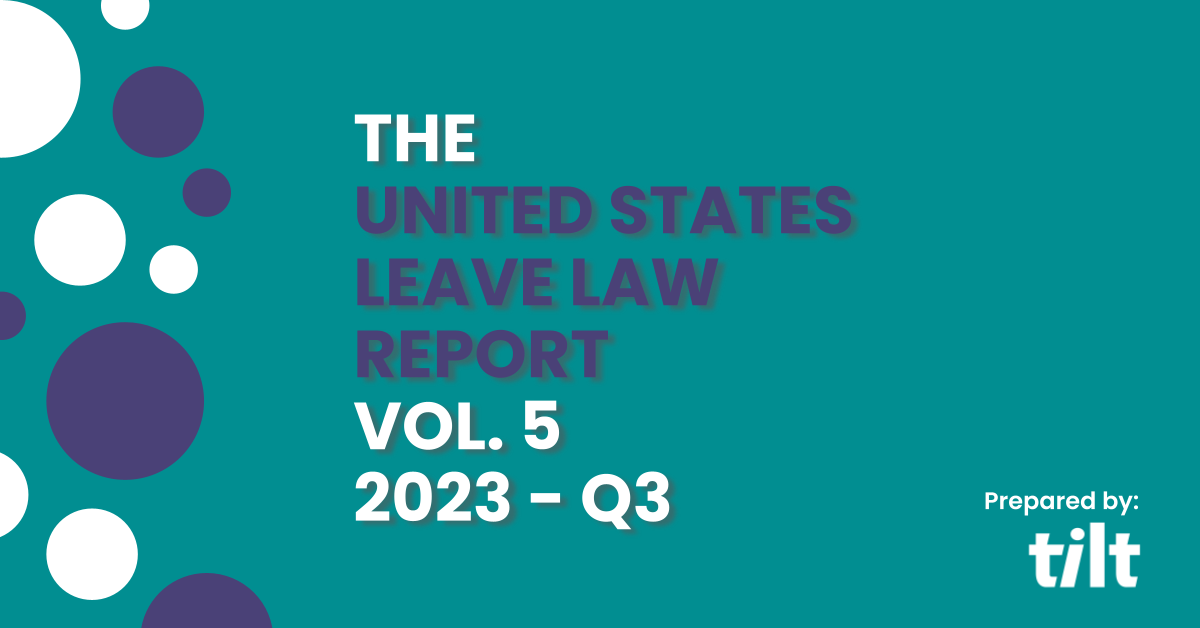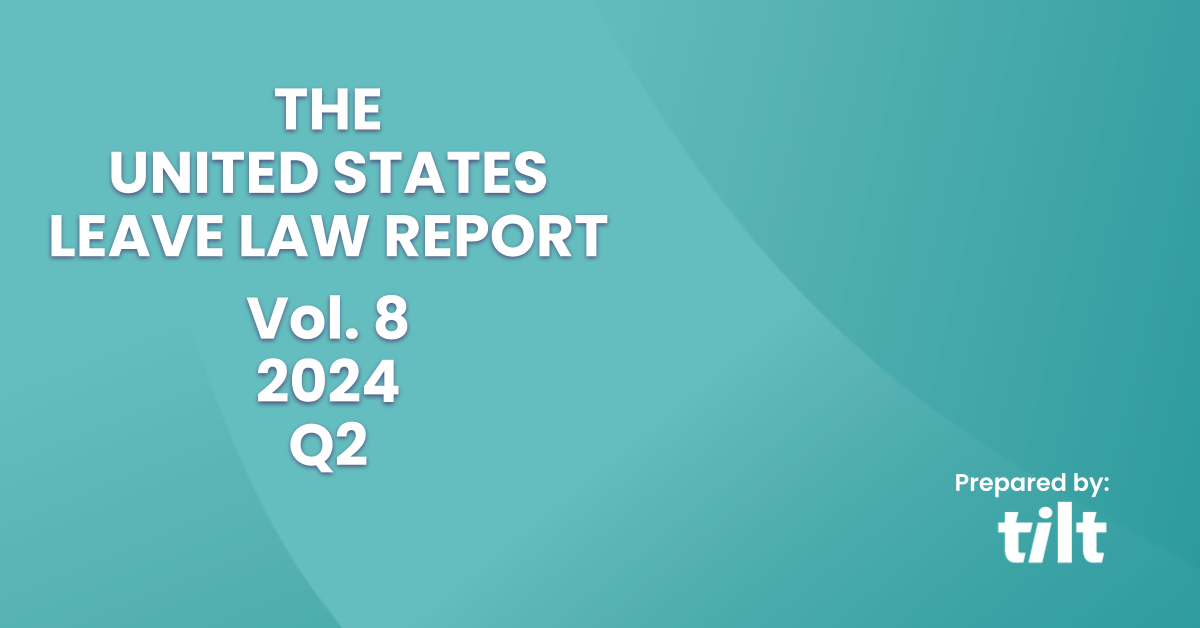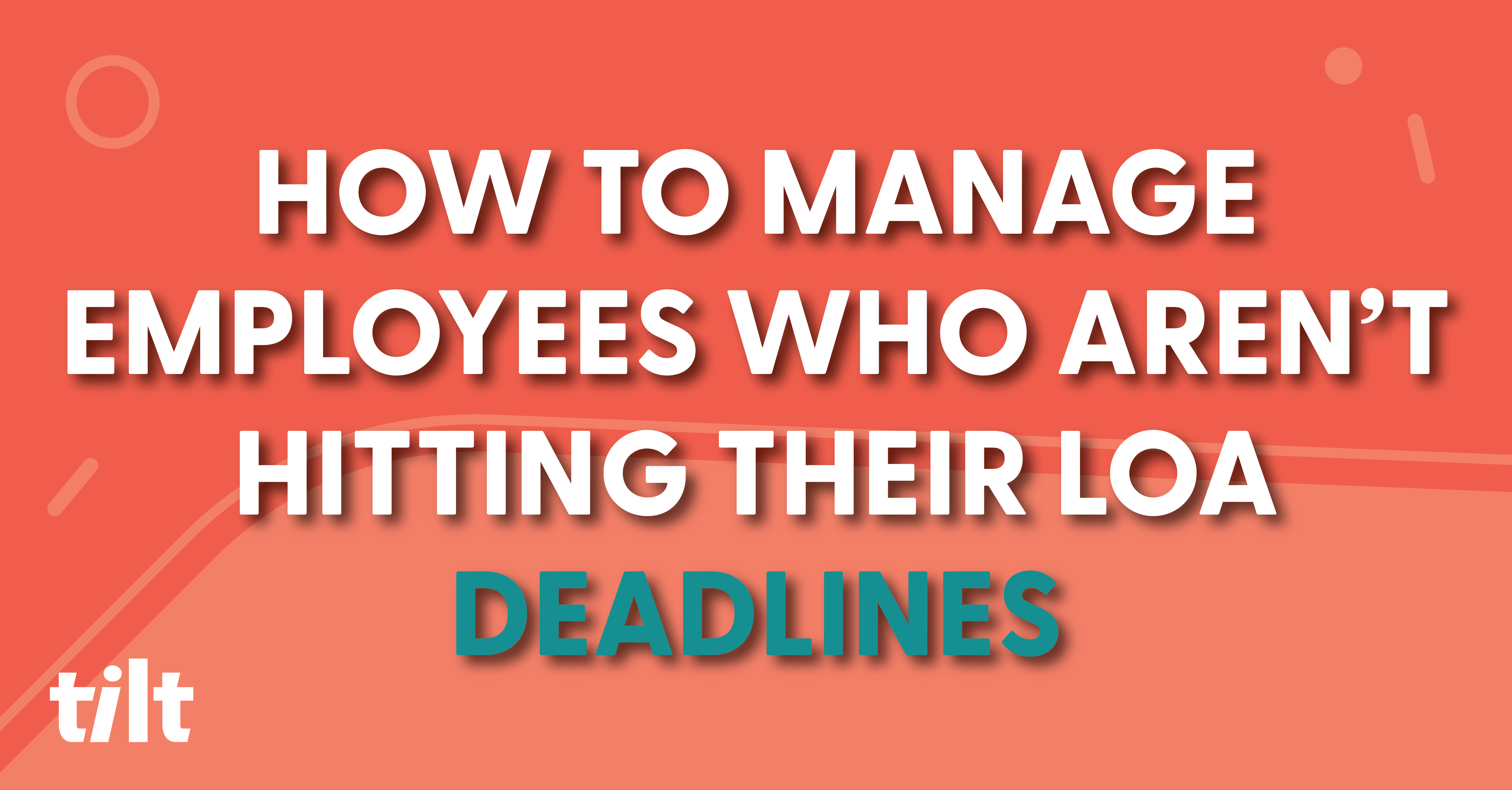The leave law landscape never sleeps, and when it comes to keeping you in the know on the latest and greatest in the world of leave, neither do we.
The United States Leave Law Report: Vol. 5 compiles the latest updates to leave programs that might impact you and your organization in one compact lil’ package.
We hope you find this information useful in your pursuit of supporting your employees and staying compliant!
Looking for all the insightful goodies from previous volumes? See what you might have missed here.
Federal Legislation: Paid Family & Medical Leave
TL;DR: States fed up with no fed paid leave launch own programs
The United States remains the only industrialized country without a national paid family leave program. In early 2023, House Democrats and Republicans formed a bipartisan working group to address that issue. The working group is exploring paid leave policy solutions with the ultimate goal of proposing federal legislation. Representative Stephanie Bice (R-OK) has publicly acknowledged that it may be difficult to get a paid leave bill through this Congress because of spending disagreements. We expect states to continue to develop and launch their own paid leave programs, adding to the existing patchwork of U.S. leave laws.
National Protections: Pregnant Workers Fairness Act
TL;DR: New protections for pregnant workers = new obligations for employers
The national Pregnant Workers Fairness Act (PWFA) went into effect on June 27th, 2023. The PWFA is modeled after the Americans with Disabilities Act (ADA) and requires employers with 15 or more employees to provide reasonable accommodations to employees affected by pregnancy, childbirth or related medical conditions. In some cases, a reasonable accommodation might mean a change to the workplace, light duty work, flexibility in work hours, or more frequent breaks. In other cases, a leave of absence may be the right accommodation.
Tilt supports leave as an accommodation under the PWFA. We apply PWFA leave to pregnancy disability dates that aren’t covered by FMLA, a state leave offering job protection or a company leave. If PWFA leave is requested outside of the standard medical recovery period (6-8 weeks), we’ll collect medical documentation so you can determine if the time can be reasonably accommodated.
National Laws: Updated Posters
TL;DR: Action required re: updated posters
FMLA Poster: In April 2023, the U.S. Department of Labor (DOL) updated its FMLA poster. The poster summarizes the major provisions of the Family and Medical Leave Act (FMLA) and includes information for filing FMLA complaints. The new poster is substantially similar to the February 2013 and April 2016 versions, which can still be used to fulfill the posting requirement.
Covered employers must display the FMLA poster in a conspicuous place where employees and applicants can see it. In addition, covered employers need to provide the notice to each employee by including the poster and/or its contents in an employee handbook or other written guidance to employees concerning employee benefits or leave rights, or by distributing a copy of the poster to each new employee upon hiring.
Workplace Discrimination Poster: In June 2023, the EEOC updated its Know Your Rights: Workplace Discrimination is Illegal poster, which now includes information about the protections under the new federal Pregnant Workers Fairness Act. The EEOC website contains information about posting requirements, and has specified that employers should remove the old poster and display the new one “within a reasonable amount of time.”
State Paid Family & Medical Leave Programs
Mandatory Vs. Voluntary
TL;DR: “Must do” > “can do” when it comes to PFML participation
At present, thirteen states (and Washington D.C.) have enacted mandatory paid family and medical leave (PFML) laws, which guarantee partial wage replacement to eligible employees who work for a covered employer and need leave for a qualifying reason. These benefits are typically administered by the state or a private carrier, but some states permit employers to manage their own voluntary PFML plans.
Mandatory PFML benefits are currently available in California, Connecticut, Massachusetts, New Jersey, New York, Rhode Island, Washington and Washington D.C. Benefits will be available in six other states in the near future: Oregon (September 2023), Colorado (2024), Maryland (2026), Delaware (2026), Minnesota (2026) and Maine (2026).
In addition, eight states have enacted “voluntary PFML” laws that permit, but do not require, employers or employees to purchase PFML insurance as a private market product: Alabama, Arkansas, Florida, New Hampshire, Tennessee, Texas, Virginia and Vermont.
Compared to mandatory programs, voluntary programs result in much lower rates of employee coverage. For example, a full quarter after New Hampshire’s voluntary program launched, only about 1% of employees working for private employers in the state were covered–and that was following a $2 million advertising campaign.
We’re going to focus on mandatory programs below because they have a much greater impact on both employers and employees.
New Mandatory PFML Laws Enacted
TL;DR: Minnesota and Maine join the PFML party, offer benefits in 2026
Minnesota (2026)
In May, Minnesota became the first state in the Midwest, and the twelfth state overall, to mandate PFML benefits for eligible employees.
Benefits will become available to eligible employees as of January 1, 2026, which is also the date that employers and employees will start paying into the program. Most employees will qualify given the low wage earnings threshold, which is about $3,500 within the state over the period of a year.
Eligible employees can receive up to 12 weeks of medical leave and up to 12 weeks of leave for other reasons (bonding, caregiving, safety or military family leave), with a maximum of 20 weeks of leave in a benefit year. In addition to partial wage replacement, the law provides job protection to employees who have worked for an employer for at least 90 days.
Maine (2026)
On July 11th, 2023, Maine became the 13th state to mandate PFML benefits for eligible employees.
Maine’s PFML program will start assessing a payroll tax on employers and employees on January 1, 2025, and benefits will become available to eligible employees on May 1, 2026. Most employees will qualify, as benefits are payable to employees who have earned six times the average weekly wage in a year, or a total of $6,622 based on today’s figures.
Eligible employees will be able to take up to 12 weeks of partially paid leave in a year for medical, caregiving, bonding, safety and military family reasons, with job protection for employees who have been employed for at least 120 days before taking leave.
Other PFML Updates
Colorado (2024)
TL;DR: CO launches PFML private plan marketplace; benefits start Jan. 2024
Employers with at least one employee working in Colorado are covered by the state’s Family and Medical Leave Insurance (FAMLI) program, which will start paying benefits to eligible employees beginning January 1, 2024.
Employers can apply to use a private plan instead of participating in the state-run FAMLI plan. Last quarter, the state opened the private plan marketplace, which lists insurance carriers who have policies that have been approved, or are pending approval, for use in a private plan.
Starting in January, the program will provide eligible employees with up to 12 weeks of paid leave for certain family, medical, military and safety reasons, and up to 16 weeks if additional time is needed due to complications related to pregnancy or childbirth. Most workers in Colorado will be eligible for paid FAMLI benefits, as the eligibility threshold is only $2,500 in wages earned in Colorado within a year.
We will start including FAMLI information in our leave communications to Colorado employees, and start applying FAMLI to their leave plans and pay calculations, towards the end of the year.
Maryland (2025 -> 2026)
TL;DR: MD PFML program pushed out one year
Maryland’s PFML program was expected to start accepting claims in 2025, but the start date was pushed to 2026 in order to give the Maryland Department of Labor additional time for program implementation, including technology acquisition, staffing, outreach planning and regulatory drafting. Employer contributions will now be required starting October 1, 2024, instead of October 1, 2023. We’ll provide more information on Maryland’s program after the implementing regulations are issued, which are expected by the end of the year.
Oregon (Sept. 2023)
TL;DR: Oregon aligns its leave laws, will start accepting PLO applications in August
Employers with one or more employees working in Oregon are covered by Paid Leave Oregon (PLO), which was originally expected to start paying benefits to eligible employees as of January 1, 2023, but was delayed to September 3, 2023 due to COVID-19. Oregon will begin accepting applications for PLO benefits on August 14.
We’ve already started sharing information about PLO with Oregon employees who have requested leave that extends beyond September 3rd. Eligible employees can receive up to 12 weeks of paid leave per year for family, medical and safety reasons, with an additional 2 weeks for pregnancy-related medical leave. Most Oregon workers will be eligible for paid benefits, as the earnings threshold is low ($1,000 in the prior year).
In other developments, the state legislature amended the Oregon Family Leave Act (OFLA) in June. OFLA applies to employers with at least 25 employees working within Oregon, and provides unpaid job protection to eligible employees for family, medical, bereavement and other reasons. The amendments are designed to ensure that OFLA and PLO run concurrently when possible, and expand OFLA’s definition of “family member” to align with the broader PLO definition.
Other Leave Law Developments
Minnesota: Pregnancy and Parental Leave Rights
TL;DR: Minnesota minimizes requirements for pregnancy/parental leave
As of July 1, 2023, Minnesota amended its existing Minnesota Parental Leave Act (MPLA), which provides up to 12 weeks of unpaid leave for the birth or adoption of a child, and for incapacity due to pregnancy, childbirth or related conditions. The law now applies to all Minnesota employers (previously, it applied only to employers with 21 or more employees at one worksite) and all employees working in Minnesota (previously, it required employees to work at least half-time for one year). As a result, all Minnesota employees are now eligible for this leave immediately upon commencement of employment.
Virginia: Organ and Bone Marrow Donor Leave
TL;DR: Job protection for eligible employees who give the gift of life
As of July 1, 2023, Virginia requires employers with 50 or more employees to provide eligible employees up to 60 business days of unpaid leave in a year for organ donation, and up to 30 business days for bone marrow donation. Employees are eligible if they have worked for the employer for at least a year and 1,250 hours in the 12 months preceding the leave. Virginia joins about a dozen other states that require private employers to provide unpaid leave for this reason.
Leave-Related Notices
TL;DR: Action required re: notices of nursing employee rights
New York State: Notice for Nursing Employees
As of June 7, 2023, Section 206-c of the New York Labor Law requires employers to provide nursing employees written notice of their rights under the law. Employers must provide the notice upon hire and annually thereafter, and upon returning to work following the birth of a child. The New York State Department of Labor has provided a model policy, which we share with New York employees preparing to return to work following the birth of a child.
Minnesota: Parental Leave Rights Notice
As of July 1, 2023, Minnesota has expanded workplace protections for expectant and new parents, and requires employers to provide a notice of their nursing employees’ rights at the time of hire and when an employee makes an inquiry about or requests parental leave. An employer that provides an employee handbook must also include this notice within the handbook. We are now including a copy of the notice within Tilt for Minnesota employees who have requested parental leave.
About Tilt
Tilt is leading the charge in all things leave of absence management through easy-to-use tech and human touch. Since 2017, our proprietary platform and Empathy Warriors have been helping customers make leave not suck by eliminating administrative burdens, keeping companies compliant, and providing a truly positive and supportive leave of absence experience for their people.







